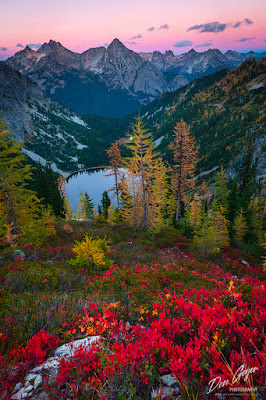 |
| Fall colors above Rainy Lake |
A visit to areas around Mt. Baker in mid-September will find the berry leaves on fire. Some of my favorite hikes for these are Boulder Ridge, Rainbow Ridge, Park Butte and Ptarmigan Ridge. I'm sure there are more!
As the month of September moves on, many more places begin to turn vibrant red throughout the range. By the end of the month, hikes near Rainy and Washington Pass along the North Cascades Highway (SR-20) become VERY popular destinations (too popular - go on a weekday and go early or late in the day).
The arrival of October sends most fall color enthusiasts into pandemonium! Not only are the reds still typically vibrant, the needles of larch begin to turn gold. Peak for the larch are typically close to mid-October. By the time they are truly at peak, much of the reds will have likely disappeared in my experience.
Larch are found on eastern side of the Cascades only, mostly (if not entirely) north of I-90. In the North Cascades, excellent places to view them are near Washington and Rainy Pass, as well as hikes reached from Winthrop, Twisp and Carlton.
 |
| Fall colors below peaks of the North Cascades |
Of course every year can be slightly different on the timing, mostly based on temperatures and weather patterns. The amount of precipitation during the summer months can also play a huge factor on the quality of colors.
In my experience, the biggest challenge to viewing late season colors are the big white snowflakes! It can snow at any time in the upper elevations of the Cascades. But the North Cascades seem to be especially prone to it, and likely in early to mid-October. I have tried to revisit one of my favorite larch viewing backpacks on multiple occasions. While my first visit at peak time went off perfectly, all my subsequent attempts have ended in being turned back by deep snow or storms. So I've learned not to take anything for granted!
There are some things to be careful for during this time. First off, it is hunting season. So if you are visiting an area outside of North Cascades National Park, be sure to where bright clothes to be easily seen.
 |
| Mount Shuksan Reflection |



